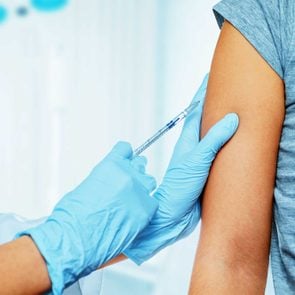I Have High-Risk HPV. Now What? Doctors Share Advice (and Assurance)
Updated: Mar. 08, 2022
Eighty percent of adults will be exposed to HPV, sometimes linked with cancer. Doctors say you should stay encouraged, even after diagnosis.
What is HPV?
The human papillomavirus—often known as “HPV”—is the most common sexually transmitted infection (STI) in the United States, according to the Centers for Disease Control and Prevention (CDC). In fact, 80 percent of us at some point in our life will be exposed to HPV, according to John Diaz, MD, the chief of gynecologic oncology at the Miami Cancer Institute, part of Baptist Health South Florida. That’s because it passes easily between people via skin-to-skin contact, typically through sexual activity.
But there’s good news: Dr. Diaz says that the overwhelming majority of the time, our body’s immune system will clear HPV just like any other infection. Here’s what he and other experts say we all should know about the high-risk types of HPV.
What does high-risk HPV mean?

There are more than 200 different types of HPV, according to 2021 research published in BMC Cancer. Of these, at least 13 are “high-risk” because they can lead to changes in the body that develop into cancer—especially cervical cancer.
Cervical cancer is the fourth most common cancer among women, and at least 90 percent of cases are thought to be HPV-related. The BMC Cancer research found that two strains—HPV 16 and 18—are responsible for 70.9 percent of cases worldwide. Dr. Diaz says that HPV 31, 33, 45, 52, and 58 make up about 20 percent of the remaining cervical cancer cases.
But there’s more to the story, says Hoosna Haque, MD, an obstetrics and gynecology specialist in New York and faculty member at Columbia University Irving Medical Center. She points to CDC data that shows high-risk HPV is also the cause of:
- 70 percent of head and neck cancer (oropharyngeal)
- 91 percent of anal cancers
- 63 percent of penile cancers
- 75 percent of vaginal cancers
- 70 percent of vulva cancers
“One of the most common misconceptions is that HPV only affects women,” Dr. Diaz adds. But rates of HPV-related anal, penile, and head and neck cancer in men rise dramatically in men, adds Dr. Haque.
How do you know if you have high-risk HPV?
“Generally, having HPV is asymptomatic, and the woman may never know without screening,” says Dr. Meenal Misal, MD, a physician in obstetrics and gynecology at The Ohio State University Wexner Medical Center.
That said, several types of HPV cause genital warts. The World Health Organization (WHO) points to HPV types 6 and 11 as the strains most likely to trigger genital warts. “Genital warts can appear as a small bump or group of bumps in the genital area,” Dr. Haque says. “They can be small or large, raised or flat, or shaped like a cauliflower.”
HPV 6 and 11 can also cause respiratory papillomatosis—a condition that can cause small, wart-like growths around the nose, mouth, and lungs. However, neither strain has a cancer association.
So, how can you find out your HPV status?
Dr. Diaz explains the most common approaches to HPV testing:
- A Pap smear, which looks for signs of cervical cancer
- Primary testing, where a doctor tests only for HPV infection
- Reflex testing, which means a doctor will check for the presence of high-risk HPV strains if a patient’s Pap smear comes back abnormal
- Co-testing, or conducting both a Pap smear and HPV test together
“When should I get tested for HPV?”
“We don’t know exactly how or exactly why, but in some women, HPV is going to cause those cells in the cervix to head toward cervical cancer,” says Greg Marchand, MD, FACOG, FACS, a board-certified OBGYN and founder of the Marchand Institute. “That’s why we do Pap smears—so we can pick it up in these women and get treatment going before [the cancer] gets too far advanced.”
While only your doctor can recommend the right protocol for you, national screening guidelines depend on what age group a woman falls into:
Under age 21
Past recommendations said that women should start undergoing Pap smears once becoming sexually active—but this rule has since changed. That’s because diagnosing cervical cancer in healthy women under age 21 is extremely rare, according to Dr. Diaz.
Once sexually active, exposure to HPV happens to most women at least once in their lives, he explains. But most young women will also clear that infection.
Waiting to intervene allows some young women’s immune systems the chance to clear the infection naturally. That means they avoid overtreatment, which can have its own set of side effects. “[HPV treatments] can cause patient discomfort, psychosocial consequences, anxiety, and healthcare costs,” Dr. Diaz explains. “You can also get false positives, and sometimes the treatment for these cervical abnormalities may have an impact on pregnancy outcomes in the future.”
Age 21-25
“The recommendation now is to start [cervical cancer] screening at 21 regardless of [when someone started having sex],” Dr. Diaz says.
But even at this age, doctors don’t tend to test for HPV, as the infection is still likely to resolve itself pretty easily. “One exception to this is that we sometimes use testing for the HPV virus as a type of ‘tie-breaker’ if we can’t really decide what [certain] cells are,” Dr. Marchand says. This means if your cervical cells look a little abnormal, but not necessarily cancerous, your doctor might use HPV testing to determine if you need closer monitoring.
Age 25-30
After receiving your first Pap smear, the American Cancer Society (ACS) recommends women continue to get screened for cervical cancer every three to five years. However, your doctor may order a reflex HPV test if your Pap smear comes back abnormal, to monitor any high-risk strains present.
But Dr. Diaz emphasizes that you still do need to visit your gynecologist annually, even if you’re not due for a Pap smear. (Here’s why.)
Over age 30
Dr. Diaz says that co-testing generally begins for women after age 30. This means that a doctor will test specifically for HPV during a patient’s regular cervical cancer screening (Pap smear).
“By the time a woman hits her 30s, any HPV infection she previously had should have cleared,” Dr. Diaz says. That’s because in most cases—9 out of 10—HPV goes away on its own within two years without any health problems, adds Dr. Haque.
But if an infection persists, doctors believe it takes between ten and twenty years for cancer to develop after the initial HPV exposure.
“So now we’re looking to identify those [one in ten] women exposed in their 20s who—for whatever reason—have not been able to clear the infection,” he explains. This way, doctors can catch it and intervene.
Why do some HPV infections not go away?
In more than 90 percent of HPV cases, our immune system will fight off the infection without us even knowing, per the CDC. But there are several reasons why it might stick around—and potentially cause problems.
“If you’re exposed to a high-risk strain, that has a higher likelihood of being persistent,” Dr. Diaz says. And remember, persistent infection is a big risk factor for HPV-related cancers.
But in general, anything that hampers our immune system can make it harder for our body to clear any infection, including HPV. That means focusing on things in our control—like exercise, diet, getting enough sleep, and managing stress levels—can make the difference in how well our immune system can clear the virus.
But what if I received the HPV vaccine?
Gardasil 9 is a popular HPV vaccine recommendation because it offers protection against seven of the high-risk HPV strains—including 16 and 18—as well as the two strains that cause genital warts, HPV 6 and 11.
“The recommendation is for both boys and girls to receive the HPV vaccine around ages 11 or 12—certainly before they become sexually active,” Dr. Diaz says. “If children don’t receive it at that age, they can get vaccinated as an adolescent, but they’ll need what’s called a catch-up dose.”
The U.S. Food and Drug Administration (FDA) recommends the Gardasil 9 HPV vaccine for all males and females ages 9 through 45. This expands on previous recommendations, which capped the vaccination age at 26.
Read more about whether you should get your HPV vaccination as an adult.
Still, if you have the vaccine and test positive for HPV, that’s normal, too. “No vaccine is 100 percent effective,” says Dr. Diaz—you can still contract high-risk HPV. But he explains that those who undergo vaccination greatly reduce their risk of an infection developing into cancer or precancerous lesions that require intervention.
“And you still need screening if you get your vaccination,” he emphasizes.
Should I worry if I test positive for HPV?
“In general, cervical cancer and precancerous changes are slow to develop or worsen,” Dr. Misal says. “So as long as you are being monitored appropriately, the risk of cervical cancer in the setting of high-risk HPV is low and can be managed.”
For example, if you’re a younger woman in good health, your doctor may move up your next routine screening to check on the infection and see if it’s cleared.
Women over 30 diagnosed with high-risk HPV may undergo what’s called a colposcopy, Dr. Diaz explains. This is a procedure where a gynecologist will examine the cervix with a microscope for evidence of any suspicious-looking cells.
“If we see something [out of the ordinary], we may take a biopsy to confirm our clinical suspicion,” he says. This biopsy result then dictates what happens next, which Dr. Diaz says is often just repeat testing within a certain time period. “Or if we find a precancerous or cancerous lesion, appropriate action is taken,” he adds.
So, in a nutshell: if you test positive for high-risk HPV, the experts suggest you try not to worry. Just make sure to follow your doctor’s screening schedule recommendation and keep your immune system in fighting form. (Here are 12 immune-strengthening habits to get you started.)
Another thing not to worry about if you test positive for HPV? Your relationship. “One misconception is to assume after a recent diagnosis of HPV is that a current partner has not been faithful,” Dr. Haque says. But she explains that it’s impossible to tell when someone became infected with HPV, and the virus can lay dormant in the body for many years.
Dr. Diaz adds that it’s also not the case that you and your partner will be giving HPV back and forth to each other. After exposure, the immune system gets to work to suppress that infection.
Check out what else doctors wish you knew about HPV and cervical cancer.


















